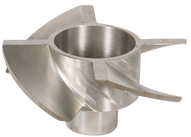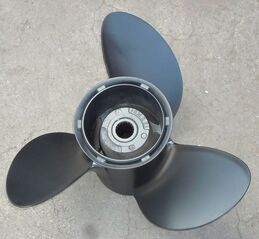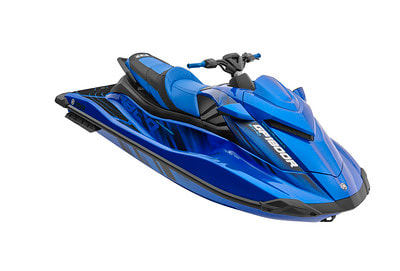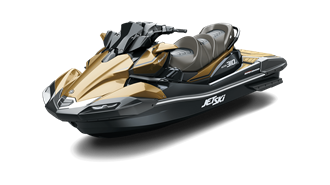|
4/29/2023 Experience Lightning-Fast Racing Performance with the Yamaha GP1800r SVHO WaverunnerRead NowThe Yamaha GP1800r SVHO is a top-of-the-line racing watercraft that offers unparalleled speed and performance. Its Supercharged High Output Marine Engine and industry-exclusive Auto Trim technology make it easy to carve through the water and reach top speeds of up to 67 mph without sacrificing balance.
This watercraft is specifically designed for racers, featuring a high-performance intake grate and jet pump that allow for less turbulent water intake, resulting in less engine pauses when accelerating through rough waters. The GP1800r SVHO's wider and deeper footwells and self-draining feature make it ergonomically designed for tight turns and a clean ride. In addition to its racing features, the Yamaha GP1800r SVHO offers seating for three and cruise assist for water recreation activities. Its versatility makes it an ideal choice for those who enjoy a variety of water sports. The Yamaha GP1800r SVHO's Supercharged, Super Vortex High Output Yamaha Marine Engine delivers up to 250 HP and a top speed of around 67-70 mph, depending on load and water conditions. Its Auto Trim system adjusts effortlessly to the conditions of your ride, making it easy to navigate even at top speeds. The GP1800r SVHO also features a RiDE reverse/braking system, TDE, and a color touchscreen display with Bluetooth capabilities for its optional audio package. Its Connext digital display also offers security features to deter unauthorized users from stealing your watercraft. The high-performance intake grate and jet pump give the Yamaha GP1800r SVHO an edge over the competition, allowing for better traction with the water and less cavitation when accelerating through choppy waters. The Auto Trim technology automatically adjusts the trim to the perfect position when slowing down to turn or accelerating, giving riders full control over the watercraft. Overall, the Yamaha GP1800r SVHO is a top-notch racing watercraft that offers unparalleled performance and versatility. Its racing metrics and versatile water recreation features make it well worth its price tag of $16,499. Bobby Boop Impellers.com
0 Comments
4/29/2023 Experience the Thrill of the 2023 Kawasaki Ultra 310LX: A High-Performance Watercraft with Enhanced FeaturesRead NowLooking for a thrilling ride on the water? Look no further than the 2023 Kawasaki Ultra 310LX, the latest model from the iconic personal watercraft manufacturer. With an array of new features and upgrades, this model promises to be a hit among water sports fans of all kinds.
So what makes the Ultra 310LX stand out from its predecessors? For starters, it boasts improved fuel efficiency, thanks to a more streamlined design that enhances stability and maneuverability on the water. Additionally, the new model features a larger and more advanced touchscreen display, offering unparalleled control and visuals while in operation. But the Ultra 310LX is more than just a pretty face. With a 1,498 cc inline four-cylinder engine, it packs a punch and can handle even the roughest waters with ease. It also comes equipped with a range of amenities, such as intelligent steering assist, smartphone connectivity options, and a top-notch sound system, ensuring a comfortable and enjoyable ride for all. But let's talk performance. The Ultra 310LX boasts a powerful 1,498cc supercharged engine capable of delivering 310 horsepower, making it one of the most influential personal watercraft models on the market. With a 160mm jet pump, axial flow, single-stage impeller, and maximum boost of 16.8 psi, the Ultra 310LX has the potential to reach speeds of up to 67 mph, depending on rider weight and water conditions. And it's not just about speed. The Ultra 310LX also features an electronic trim system that allows riders to adjust the trim angle while in motion, improving handling and stability in various water situations. Plus, with a fuel range of around 100-110 miles, this model is built to keep you going for longer. So whether you're a novice or an expert rider, the 2023 Kawasaki Jet Ski Ultra 310LX is sure to impress with its remarkable acceleration, peak speed capabilities, and enhanced handling characteristics. Ready to dive in and experience the thrill for yourself? Buckle up and enjoy the ride! Bobby Boop Impellers.com 4/29/2023 Exploring the Different Styles of Jet Pumps for Watercraft: A Comprehensive GuideRead NowJet pumps are an essential component of watercraft propulsion systems. They work by drawing in water through an intake, compressing it, and then expelling it through a nozzle to create thrust. There are several different styles of jet pumps, each with its own unique characteristics and advantages. In this blog post, we'll explore some of the most common styles of jet pumps used in watercraft.
In conclusion, jet pumps come in various styles, each with its unique features and applications. Axial-flow jet pumps are the most common in personal watercraft, mixed-flow jet pumps are popular in larger watercraft such as jet boats, radial-flow jet pumps are known for their high efficiency and ability to handle high flow rates, venturi jet pumps are specialized for high suction applications, and ejector jet pumps are commonly used in industrial applications. Understanding the different styles of jet pumps can help you choose the best option for your watercraft's specific needs. Bobby Boop Impellers.com How to Build a Jet Ski Impeller
If you're a fan of personal watercraft and want to improve their performance, building your own jet ski impeller could be a great option. Impellers are a key component in the propulsion system of jet skis and are responsible for generating thrust by drawing water into the craft's impeller housing and then expelling it through a nozzle at high speeds. Here's a step-by-step guide on how to build a jet ski impeller: Step 1: Design the Impeller The first step in building a jet ski impeller is to design it. You can use 3D modeling software to create a detailed design, or you can draw the impeller by hand on paper. The design should include the shape and size of the blades, the diameter of the impeller, and the pitch angle of the blades. Step 2: Build the Casting Jig Once you have the design, the next step is to build a casting jig. The casting jig is used to make the mold for the impeller. You can build a casting jig out of wood or metal, depending on your preference. The jig should be the exact shape of the impeller and should have a hollow core to allow the molten metal to fill the mold. Step 3: Cast the Impeller After the casting jig is completed, you can cast the impeller. You'll need to melt the metal, typically aluminum, in a furnace until it becomes liquid. Then, pour the molten metal into the casting jig and allow it to cool and harden. Once the metal has hardened, you can remove the impeller from the jig. Step 4: Clean and Finish the Impeller After the impeller has been removed from the casting jig, it will have rough edges and may require additional finishing. You can use a grinding wheel or sandpaper to smooth out the edges and give the impeller the desired finish. Or MACHINE Impeller Machining an impeller out of aluminum or steel is another option for building a custom impeller. Machining an impeller can offer more precise control over the design and manufacturing process, allowing for greater customization and tighter tolerances. However, machining an impeller requires specialized equipment and expertise, and may be more expensive than casting an impeller. One advantage of machining an impeller is that it allows for the use of stronger materials than those typically used in cast aluminum impellers, such as stainless steel or titanium. These materials can offer improved durability and resistance to wear, making them ideal for high-performance jet ski applications. However, machining an impeller requires a solid block of material, which can be expensive and wasteful compared to the casting process. Machining also requires specialized equipment, such as a CNC machine or lathe, and may require more time and expertise to produce a finished product. Step 5: Install the Impeller Once the impeller has been cleaned and finished, it's ready to be installed in the jet ski. The impeller should be placed in the impeller housing and secured in place with bolts or screws. In conclusion, building your own jet ski impeller can be a rewarding and cost-effective way to improve your craft's performance. By following these steps, you can create an impeller that's customized to your needs and preferences. Remember, it's important to take your time with each step to ensure the impeller is built correctly and works safely. A custom impeller typically starts at $10k to build from scratch depending on size. Impellers.com Fishing is a beloved pastime for many people around the world. From the quiet streams to the vast ocean, fishing offers a peaceful escape from the stresses of everyday life. However, if you're looking to take your fishing experience to the next level, why not try fishing on a jet ski? In this article, we'll discuss the benefits of fishing on a jet ski and how to get started. Benefits of Fishing on a Jet Skis Mobility and Versatility One of the biggest benefits of fishing on a jet ski is its mobility. Unlike traditional fishing boats, jet skis are small, nimble, and can get into tight spots. This means you can quickly and easily move from spot to spot, giving you the flexibility to chase the fish wherever they may be. Additionally, jet skis are easy to launch and retrieve, making it a hassle-free option for a quick fishing trip.
Getting Started
In conclusion, fishing on a jet ski can be a fun and exciting way to enjoy your favorite pastime. With its mobility, speed, and low impact on the environment, jet ski fishing offers a unique experience that is sure to enhance your fishing adventures. So, grab your fishing gear, hop on your jet ski, and get ready to make some unforgettable memories on the water. Another benefit of fishing on a jet ski is that manufacturers have started to recognize the potential of jet skis as fishing platforms and have begun to develop accessories and modifications to make them even more suitable for fishing. Some new models of personal watercraft (PWC) now come with fishing-specific accessories, such as rod holders, baitwells, and livewells.
For example, Sea-Doo offers a "Fish Pro" model that comes equipped with a removable cooler with a fishing rod holder, trolling mode, and a Garmin fish finder. Yamaha has also introduced the "FX HO Cruiser" model, which includes a fish finder and two dedicated fishing rod holders. These new fishing-oriented models of PWCs are designed to make it easier and more comfortable for anglers to fish from a jet ski. These modifications not only increase the fishing capabilities of jet skis but also provide anglers with a unique and thrilling fishing experience that cannot be matched by other fishing boats. In addition, fishing on a jet ski is often less expensive than owning and maintaining a traditional fishing boat, making it an affordable alternative for anglers who want to enjoy fishing without breaking the bank. With the right equipment and accessories, jet skis can be just as effective as traditional fishing boats, allowing anglers to enjoy the thrill of fishing in a more compact and agile package. Overall, fishing on a jet ski offers many benefits that cannot be matched by other fishing methods. Whether you are looking for a unique and exciting fishing experience, or simply want to save money on your fishing trips, a jet ski can be a great option for anglers of all levels. Bobby Boop Impellers.com Although they may sound alike, impellers and propellers have distinct purposes and functions. Despite being employed to propel a boat, they operate in fundamentally different ways. A propeller functions as a fan, pushing against fluid to generate forward movement by converting rotational force into linear motion. On the other hand, an impeller serves as a rotor that is typically integrated into a pump and generates a suction force, drawing fluid into a vehicle or engine. To gain a better understanding of these elements and their functions, let's delve deeper into each of them. Impeller In simple terms, an impeller is a rotor component that generates a suction force within a pump system. In the case of a boat, the impeller is composed of a series of flexible rubber vanes attached to a central hub, which rotates around an axis inside a stainless-steel liner housed within the pump. This mechanism pumps cold water into the boat's engine to cool it down while under load, and is also used to bring water from outside the boat into the plumbing system. The impeller features an inlet that allows water to flow into the boat, and the rubber vanes propel the fluid through the inlet. As the rotating component of a centrifugal pump, the impeller drives fluid away from the center of rotation, transferring energy from the pump to the water and creating velocity that propels the water outward from the pressurized pump. The impeller can be likened to an early and rudimentary version of the Archimedes screw. Impellers can be classified into three different categories based on solidity: high, medium, and low. High solidity impellers feature large, square-shaped blades that are primarily used for gas dispersion and blending of high or medium viscosity fluids. The specific design and size of these blades prevent gas from bypassing them, which could easily occur if the blades were narrower. In contrast, low solidity impellers have much thinner blades than high solidity ones and are typically employed for blending low viscosity fluids and solid suspension. Medium solidity impellers fall somewhere between high and low solidity types. Propeller A propeller can be thought of as a type of fan that generates thrust by pushing fluid away from it, converting rotational motion into linear motion (extrinsic). In the context of a boat, the propeller works by creating thrust and generating power to propel the boat forward. Propellers typically have three or four blades that rotate around an axis, driving the boat through the water. As the blades rotate, the water pressure behind each blade increases, propelling the boat forward. The angle at which the blades protrude from the hub allows water to flow from the front of the propeller to the rear without pushing water to the sides. Generally, increasing the number of blades on a propeller can enhance the power generated by the vehicle and reduce drag. The thrust generated by propellers can be explained by either Bernoulli's theorem or Newton's laws of motion. Cavitation is a common problem in centrifugal pumps that can cause damage to the pump and decrease its efficiency. Cavitation occurs when the pressure in a fluid drops below the vapor pressure of the liquid, causing bubbles to form and then collapse. This can lead to erosion, noise, vibration, and reduced pump performance. In this post, we'll discuss the common causes of cavitation in centrifugal pumps and how to prevent it.
Damaged Impeller A damaged impeller is one of the most common causes of cavitation. The impeller is the rotating part of the pump that moves the fluid. When the impeller is damaged, it can create turbulence and low-pressure areas that lead to cavitation. To prevent this, it is important to regularly inspect and maintain the impeller. Bad Wear Ring The wear ring is a stationary part of the pump that surrounds the impeller. It helps to maintain the proper clearance between the impeller and the pump housing. A bad wear ring can cause cavitation by allowing too much fluid to leak back into the inlet side of the impeller, creating a low-pressure area and leading to cavitation. To prevent this, the wear ring should be regularly inspected and replaced as needed. Bad Driveline Seal The driveline seal is the seal between the pump and the motor. A bad driveline seal can allow air to enter the pump, which can cause cavitation. To prevent this, the driveline seal should be regularly inspected and replaced as needed. Bad Pump Seal The pump seal is the seal that prevents the fluid from leaking out of the pump. A leaking pump seal can allow air to enter the pump, leading to cavitation. To prevent this, the pump seal should be regularly inspected and replaced as needed. In conclusion, cavitation can be caused by a damaged impeller, bad wear ring, bad driveline seal, and pump seal. To prevent cavitation, it is important to regularly inspect and maintain these components. By doing so, you can improve the efficiency of your pump and extend its lifespan. If you are experiencing cavitation in your centrifugal pump, contact Impellers.com for expert advice and pump solutions. Our team of engineers can help you diagnose and solve any pump problems you may be experiencing. Bobby Boop Impellers.com 4/27/2023 Boat Buyers Beware: Why Checking a Boat's History is Crucial Before Buying, and How Boat History Report Can HelpRead NowIf you're planning to buy a boat this summer, congratulations! You're in for a lot of fun and adventure on the water. However, before you get too excited about your purchase, there's an important step you should take: check the boat's history with Boat History Report.
Boat History Report is an online service that can help you avoid buying a boat with costly hidden problems. By looking up the boat's history with its Hull Identification Number (HIN), State Registration Number, or USCG Documentation, you can get a comprehensive report that checks for damage including accidents, hurricanes, fire, theft, run aground, submerged, total loss, registration history, title history, recalls, warranties, and more. Why is checking a boat's history important? Just like with a car, a boat may have a hidden history of accidents or other problems that can affect its performance, safety, and value. For example, a boat that has been in a serious accident may have hidden damage to its hull or engine that can cause problems down the road. A boat that has been submerged in water may have corrosion or electrical issues that can be difficult and expensive to fix. And a boat that has been stolen and recovered may have a murky ownership history that can make it difficult to sell or insure. By using Boat History Report, you can get a clear picture of a boat's history and avoid any surprises later on. The report is easy to order online, and you can get it within minutes. The cost is reasonable, especially compared to the potential costs of buying a boat with hidden problems. So, if you're planning to buy a boat this summer, make sure to check its history with Boat History Report https://boathistoryreport.com/. It's a small investment that can pay off big time in the long run. Happy boating! Bobby Boop Impellers.com Are you the proud owner of a Sea Doo model watercraft or boat with a damaged impeller? Or perhaps you have upgraded your watercraft and now have a used impeller lying around? Look no further! At Impellers.com, we are interested in buying your used or damaged impellers for Sea Doo 4 stroke models.
Why sell your impeller to us? First and foremost, we are experts in impeller repair and replacement. We have years of experience in the industry and can recognize the value of a used or damaged impeller. By selling your impeller to us, you can be sure that you are getting a fair price for your item. Additionally, selling your impeller to us is an eco-friendly option. Rather than throwing away your damaged or unused impeller, you can help reduce waste by selling it to us. We will either repair the impeller or use its parts to repair other impellers, ensuring that it doesn't end up in a landfill. At Impellers.com, we are interested in buying impellers for Sea Doo 4 stroke models. Whether your impeller is damaged or used, we want to hear from you. Selling your impeller to us is a hassle-free process. Simply contact us and provide us with some basic information about your impeller, including its condition, model, and any other relevant details. We will get back to you with a quote and arrange for payment and pick-up of your impeller. Don't let your used or damaged impeller go to waste. Sell it to Impellers.com today and help keep our waterways clean and healthy while earning some extra cash. Impellers.com To make a propeller testing session worthwhile, there are several important factors that must be considered. According to Dirk Bjornstad, the brand manager at Mercury Propellers, many people underestimate the number of variables and the level of stringency required when testing. Simply adjusting pitch alone won't suffice; blade count, cup, rake angle, and blade area are equally crucial. Additionally, a stepped-bottom design will necessitate different prop requirements than a standard one. By carefully examining these factors, you can make an informed decision.
When consulting with a customer, Brett Anderson, the president of BBlades Professional Propellers, emphasizes understanding their main goals and what they hope to achieve. Common objectives include getting on plane quickly, having great mid-range, and outpacing a friend's boat. However, even the most knowledgeable prop specialist cannot assist without accurate knowledge of your boat, such as the manufacturer's recommended maximum rpm for the engine. As fuel prices rise in the spring, Bjornstad reported that he received calls from people seeking to save money. The most prevalent misconception was that increasing pitch could result in fuel savings. However, this has the opposite effect as it puts more strain on the motor, leading to increased fuel consumption. To save money, aim for the lower end of your motor's recommended rpm range. This will reduce gas consumption during high-speed runs as the engine will be turning at a lower rpm. Bobby Boop Impellers.com |
Details
Jet Ski & Boat Magazine - Your Ultimate Guide to Water AdventuresWelcome to Jet Ski & Boat Magazine E Zine, your go-to source for all things related to water sports and personal watercraft. Our E zine magazine is dedicated to providing you with the latest news, tips, and stories from the world of jet skiing, boating, and other exciting water activities. Categories
All
Archives
|
LOW PRICE Guarantee! We will meet or beat any advertised price!
|
|
We have the impeller edge on lowest prices, highest quality and performance impellers world wide
Personal Watercraft Jetski ATV Motorcycle Snowmobile SXS & Sport boat JetBoat Performance Since 1994
sportboatparts.com JetSkiParts.biz SportJetBoat.com
sportboatparts.com JetSkiParts.biz SportJetBoat.com
2024 Copyright Impellers.com


 RSS Feed
RSS Feed


